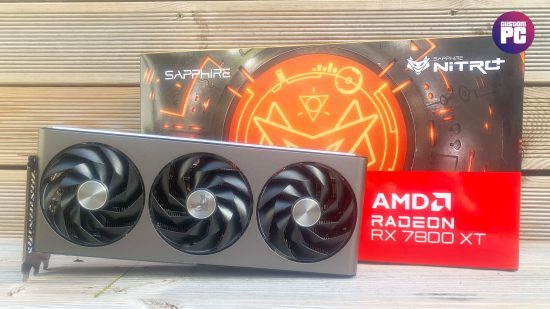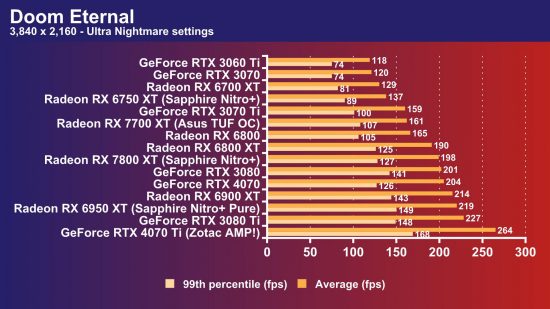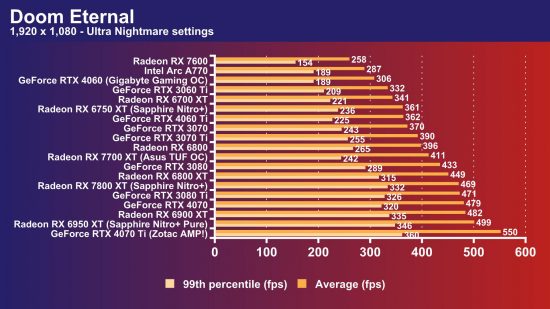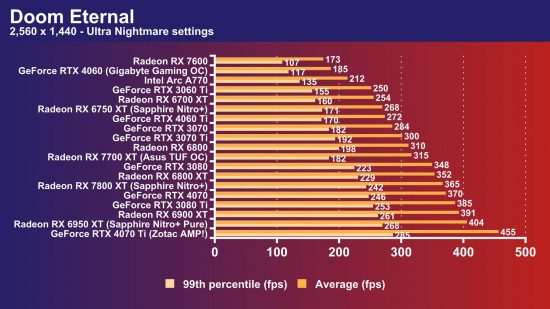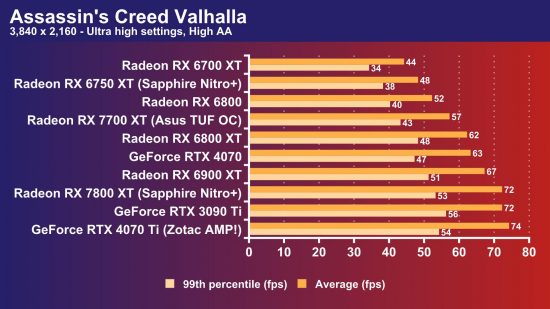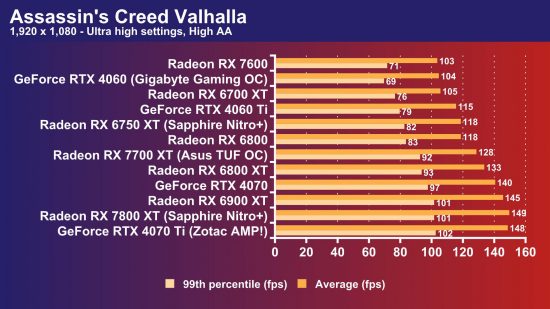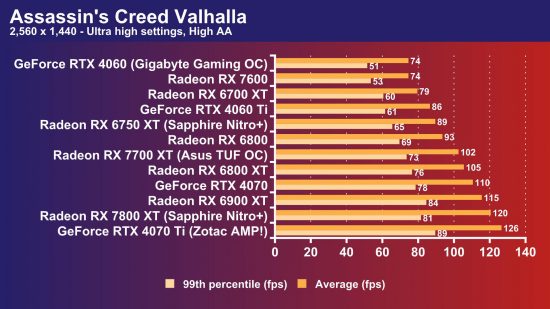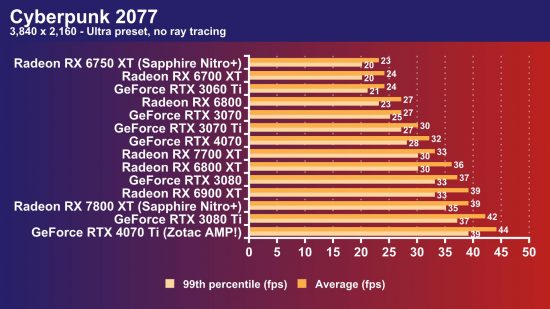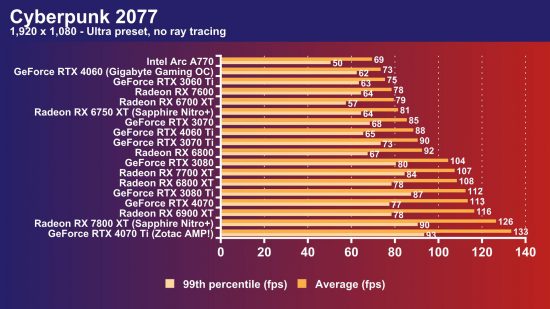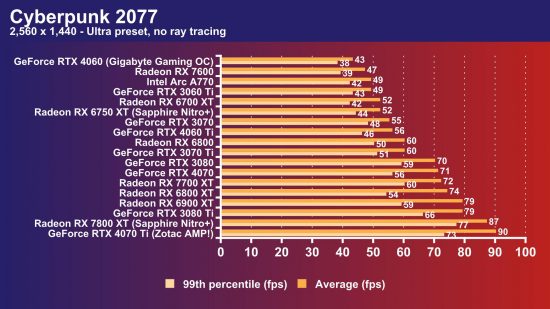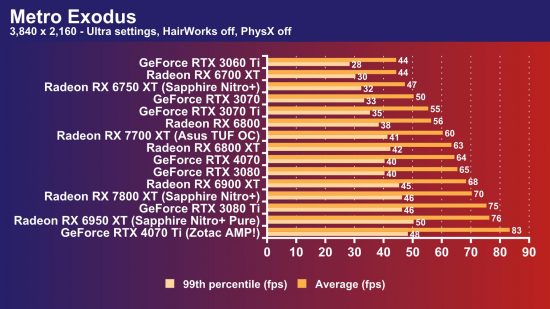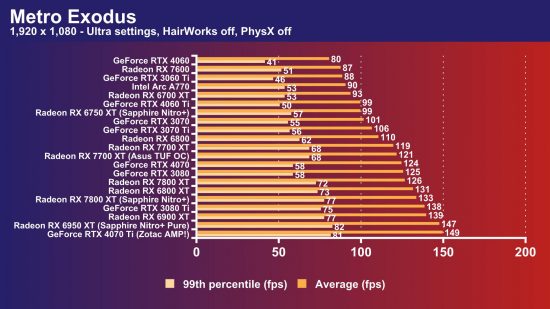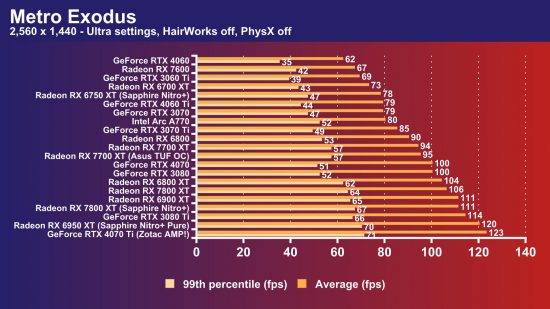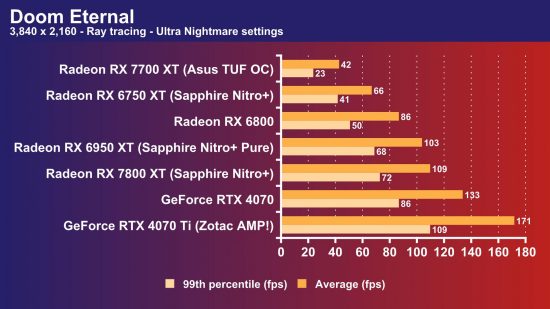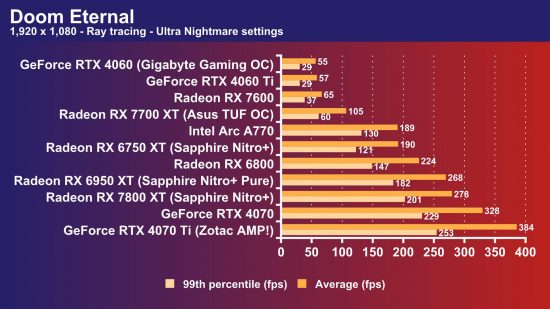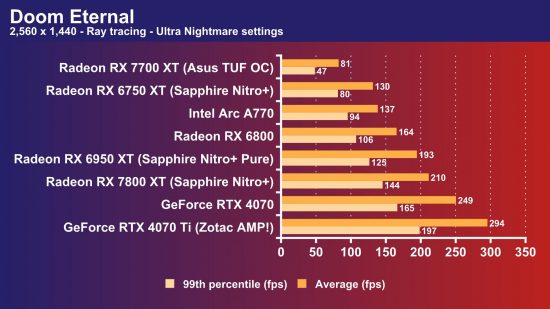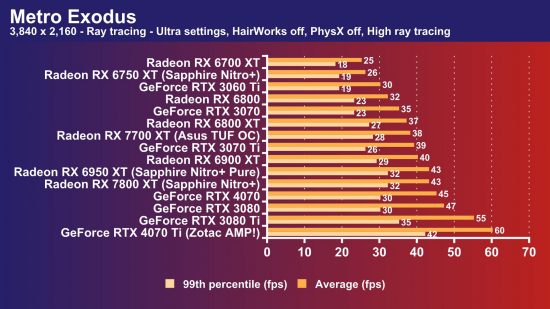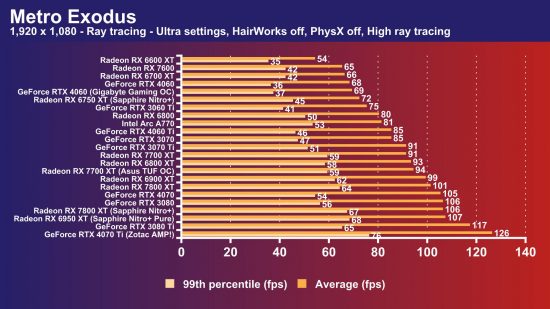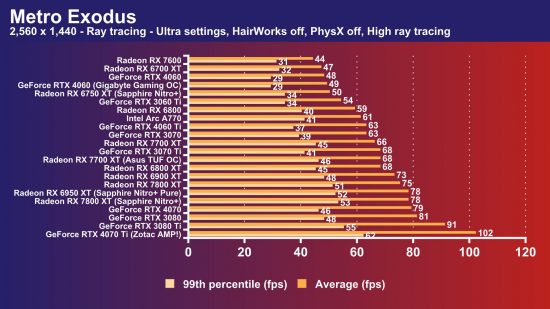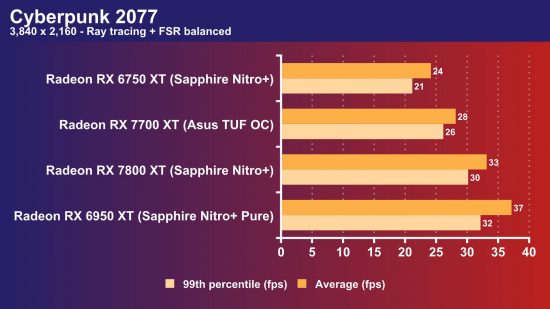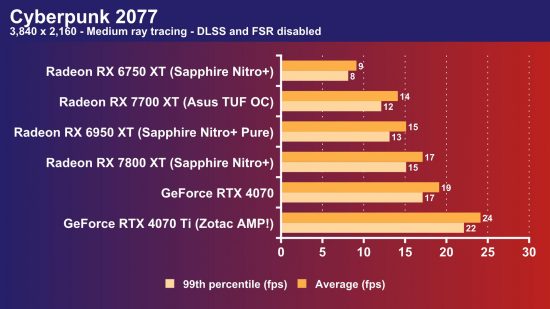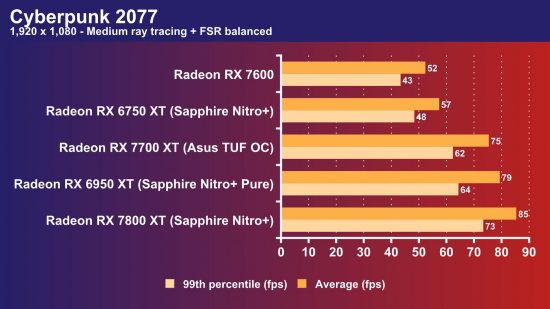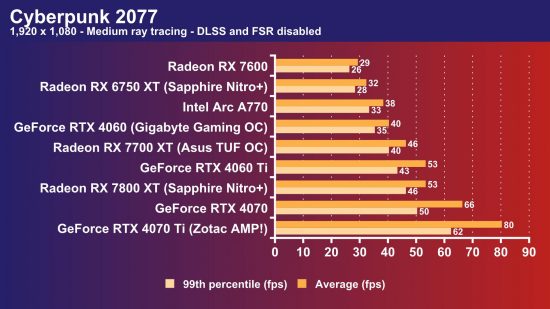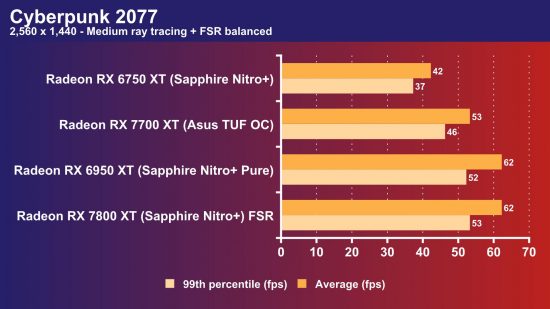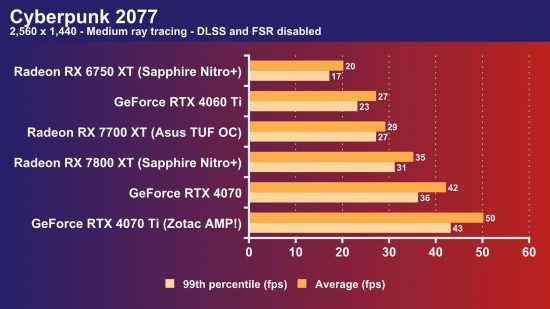Our Verdict
80%The Radeon RX 7800 XT leaves the RTX 4060 Ti in the dust, and beats the RTX 4070 in a lot of gaming tests. Nvidia is still the ray tracing master, and AMD needs some frame generation tech, but the aggressive price makes this the current best sub-$500 gaming GPU.
You can now stop pointedly checking your watch and frowning in AMD’s direction – the new mid-range AMD graphics cards are finally here, after what feels like a wait longer than between recent A Song of Ice and Fire books. The Radeon RX 7800 XT helps fill the gaping chasm that stretched between the Radeon RX 7600 and the Radeon RX 7900 XT, with AMD hoping it will ruffle the feathers of the GeForce RTX 4070.
What’s more, AMD is being extremely aggressive with the Radeon RX 7800 XT price. It costs just $499, making it $100 cheaper than the GeForce RTX 4070, and ostensibly the same price as the GeForce RTX 4060 Ti 16GB. Given that it comes with 16GB of memory, and an ‘8’ rather than a ‘6’ in its model name, it looks like a bargain on the face of it. Is the Radeon RX 7800 XT the new mid-range graphics king? Let’s dissect it and find out.
At Custom PC, we’ve been reviewing the latest gaming GPUs since 2003, and we run a number of grueling GPU benchmarks in order to gauge performance. Our game tests include measuring the frame rate in Cyberpunk 2077, Doom Eternal, and Metro Exodus, all with and without ray tracing, and we also test with Assassin’s Creed Valhalla. For more information, see our How we test page.
AMD Radeon RX 7800 XT Navi 32 GPU
The core silicon of the Radeon RX 7800 XT is the new Navi 32 GPU, which is also used in the new Radeon RX 7700 XT, and is built by TSMC on a 5nm process. However, the RX 7800 XT here goes all out on the spec of Navi 32.
There are 60 AMD RDNA 3 compute units, each with a corresponding ray tracing core and two AI accelerators. The latter are the equivalent of Nvidia Tensor cores, but AMD has yet to use them for any gaming applications. It’s rumored that a future version of FSR 3 AI frame generation will take advantage of them, but at the moment they’re going unused.
Those 60 compute units also give you a total of 3,840 stream processors, which is huge for the price. That’s over 85 percent more than you get in the Radeon RX 7600. As a point of comparison, the 7800 XT’s nominal predecessor, the $649 Radeon RX 6800 XT, was based on the Navi 21 GPU, and had 4,608 stream processors. However, this GPU was $150 more expensive at launch and used the RDNA 2 architecture, rather than RDNA 3, and it’s always worth bearing in mind that the design and efficiency of different GPU architectures have a dramatic impact on performance per core.
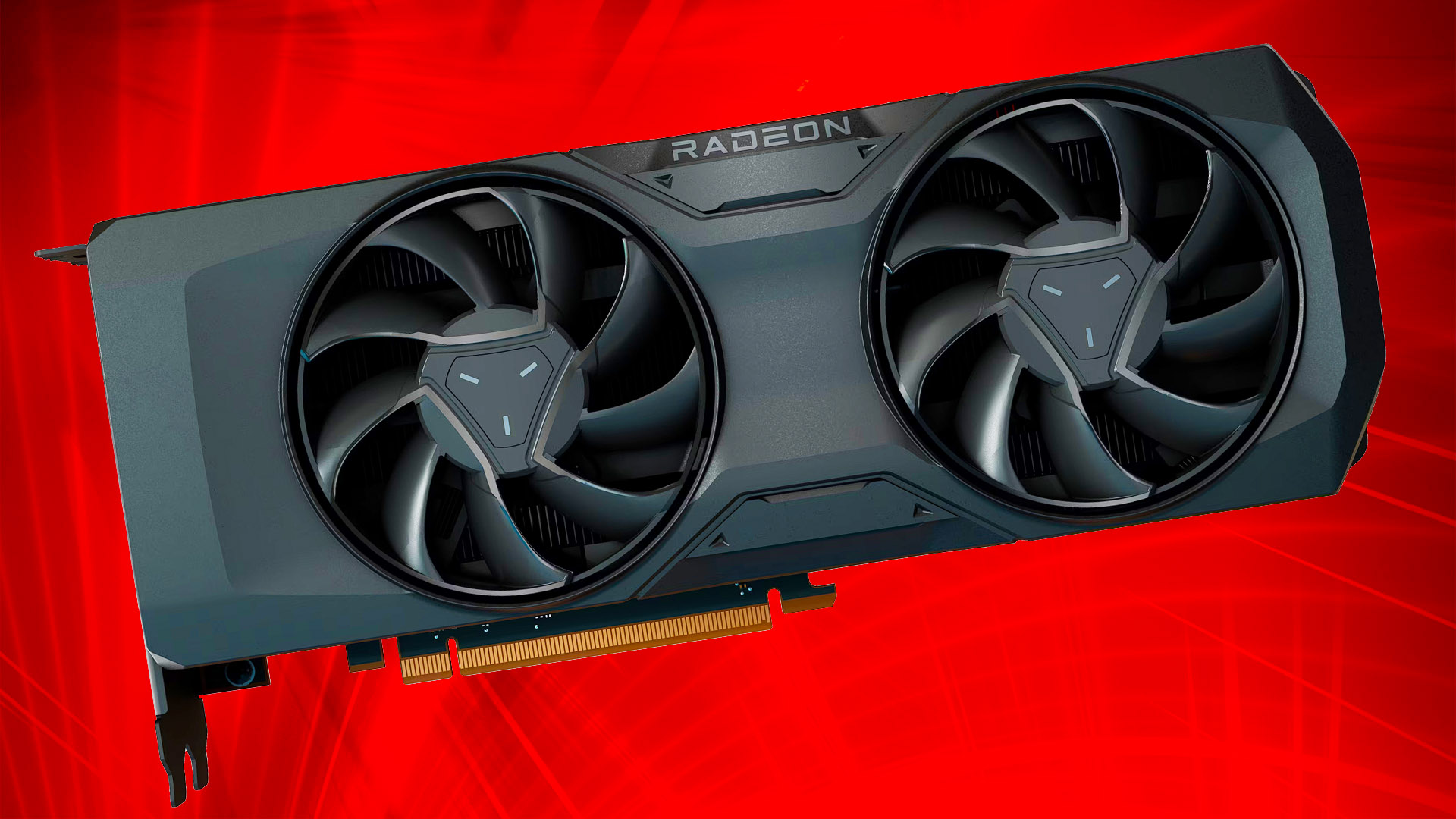
AMD Radeon RX 7800 XT memory
Unlike the Radeon RX 7700 XT, the RX 7800 XT has 16GB of GDDR6 memory running at 2425 MHz (19.5 GHz effective), and it’s attached to a spacious 256-bit memory interface as well, giving it 624GB/s of total memory bandwidth.
In terms of memory, this spec absolutely dwarfs the VRAM configuration of the standard GeForce RTX 4060 Ti 8GB, which has half as much memory attached to a 128-bit interface, giving you just 288GB/s of bandwidth. It’s also a fatter setup than you get from the GeForce RTX 4070.
Like Nvidia, AMD has also supplied a beefy amount of cache with the Radeon RX 7800 XT, which contains 64MB of L3 Infinity Cache. This is designed to help avoid cache misses, reducing the load on the memory bus, although that’s less of a problem for the Radeon RX 7800 XT than for the GeForce RTX 4060 Ti 16GB, as the former has a much wider bus.
Sapphire Nitro+ Radeon RX 7800 XT
There’s a satisfying heft to the Sapphire Nitro+ Radeon RX 7800 XT when you pull it out of its antistatic bag. It feels like a $549 graphics card used to feel a few years ago, before graphics card pricing went silly. Sapphire has priced its card $50 above the $499 MSRP, but it justifies this with a chunky cooler, loads of lighting and a serious overclock.
It’s a massive card, measuring 32cm wide and taking up three expansion slots, and there’s a seriously chunky backplate on the back. Sapphire even provides a support bracket to prevent the card from sagging in your case and putting undue strain on your motherboard’s 16x PCIe slot.
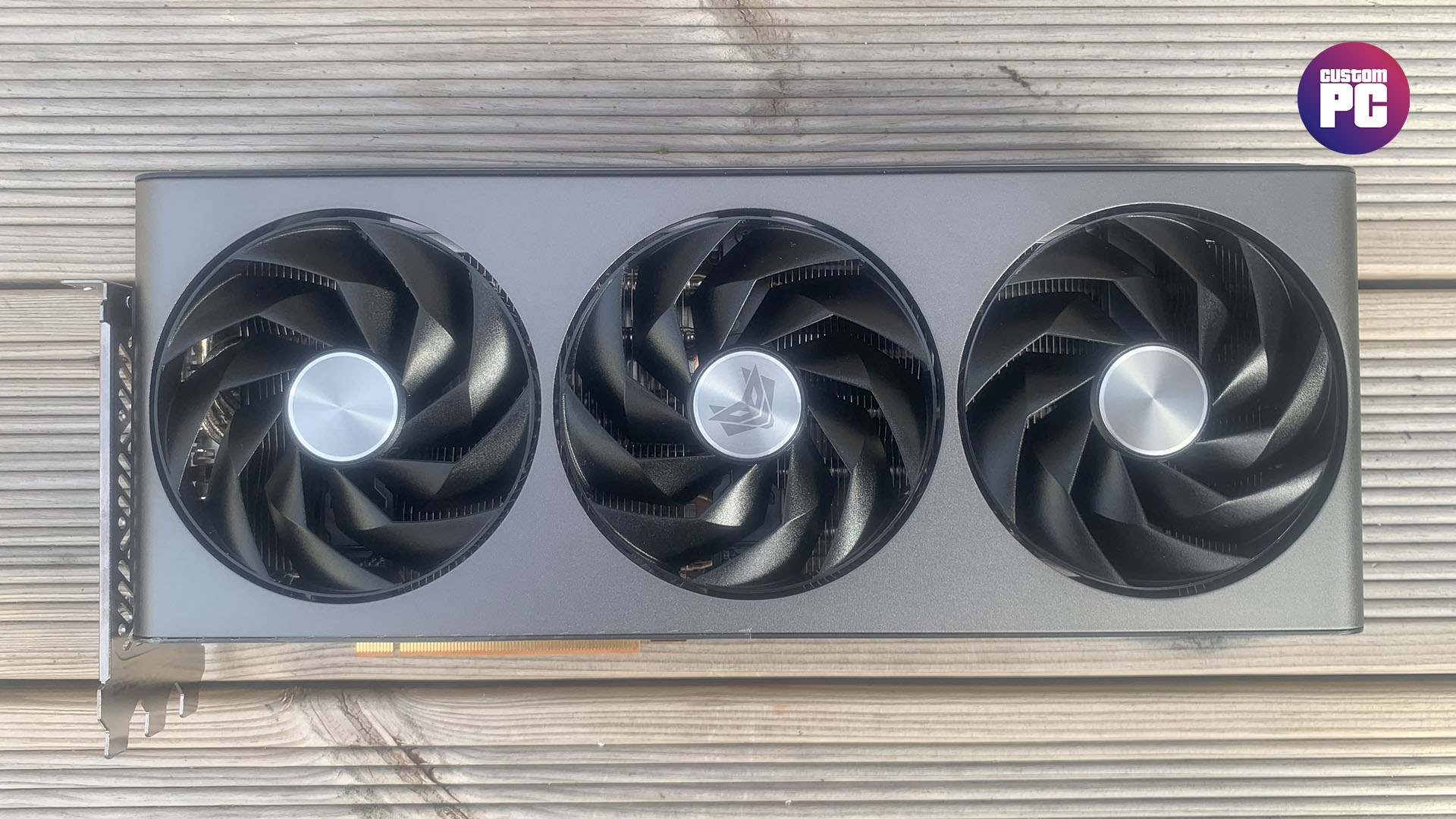
It also features some great-looking, and bright, RGB lighting, with a diffuse strip running across the top edge of the card, and another lit-up Sapphire logo on the backplate – all areas you can see clearly through a case window without having to mount the card vertically.
You can control the RGB software using Sapphire’s own software, which works well, although it isn’t particularly flexible. However, there’s handily also a 3-pin ARGB connector so you can link the card to your motherboard’s control software. What’s more, this time Sapphire has put it in a sensible place, next to the pair of 8-pin PCIe power cables, so you can easily route it without creating unnecessary mess.
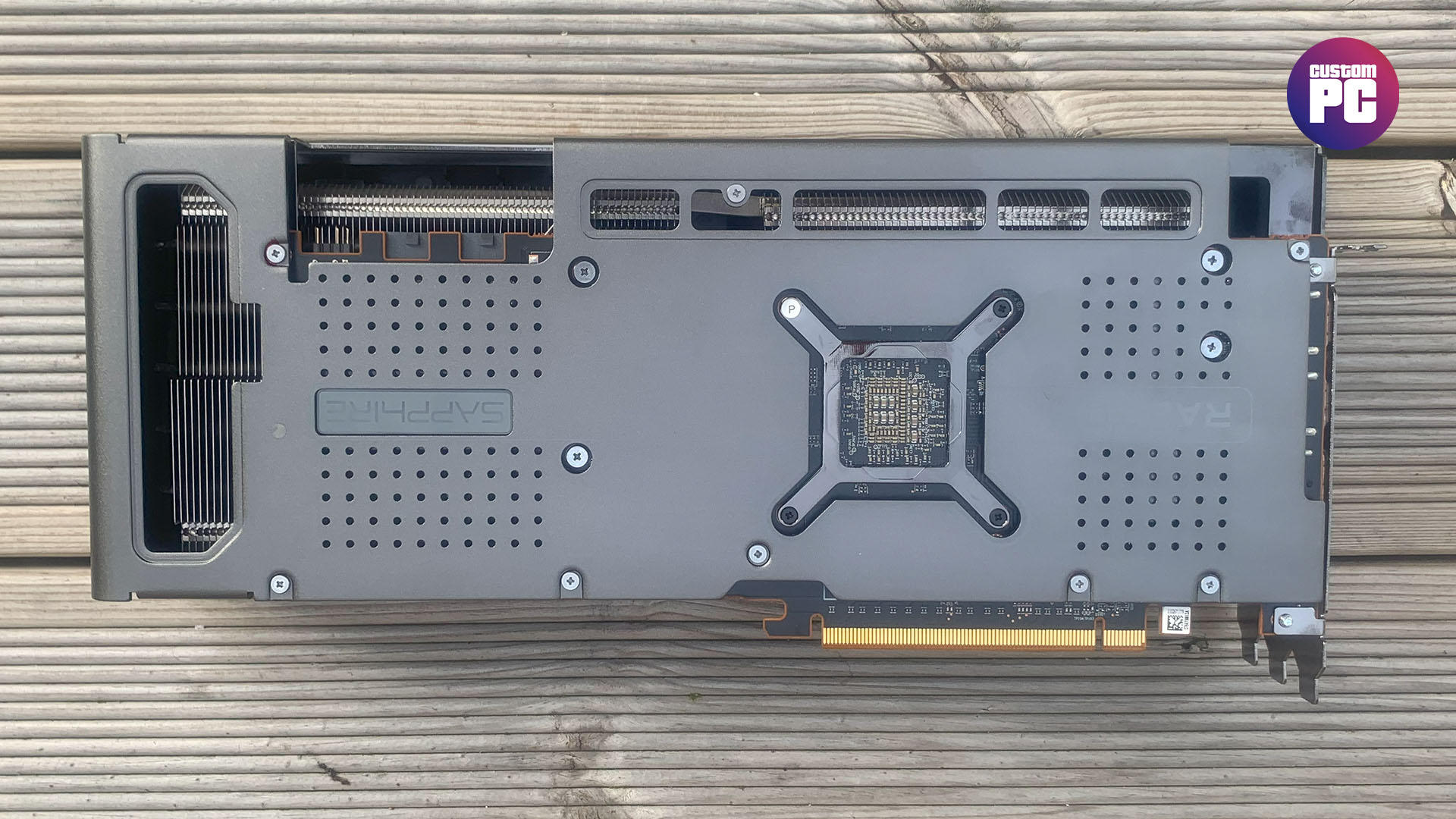
Sapphire has also applied a serious overclock to this Nitro+ card, taking the Radeon RX 7800 XT’s 2430MHz boost clock all the way up to 2565MHz. This should be enough of a clock speed bump to make a noticeable impact in our benchmarks, and the card was regularly boosting to over 2700MHz during our tests.
Meanwhile, the cooling system features a large array of heatsink fins attached to several large composite heatpipes, with airflow provided by three large fans. It works well, keeping the 7800 XT temperature down to 59°C with an 85°C hot spot at peak load, and without making a horrible noise.
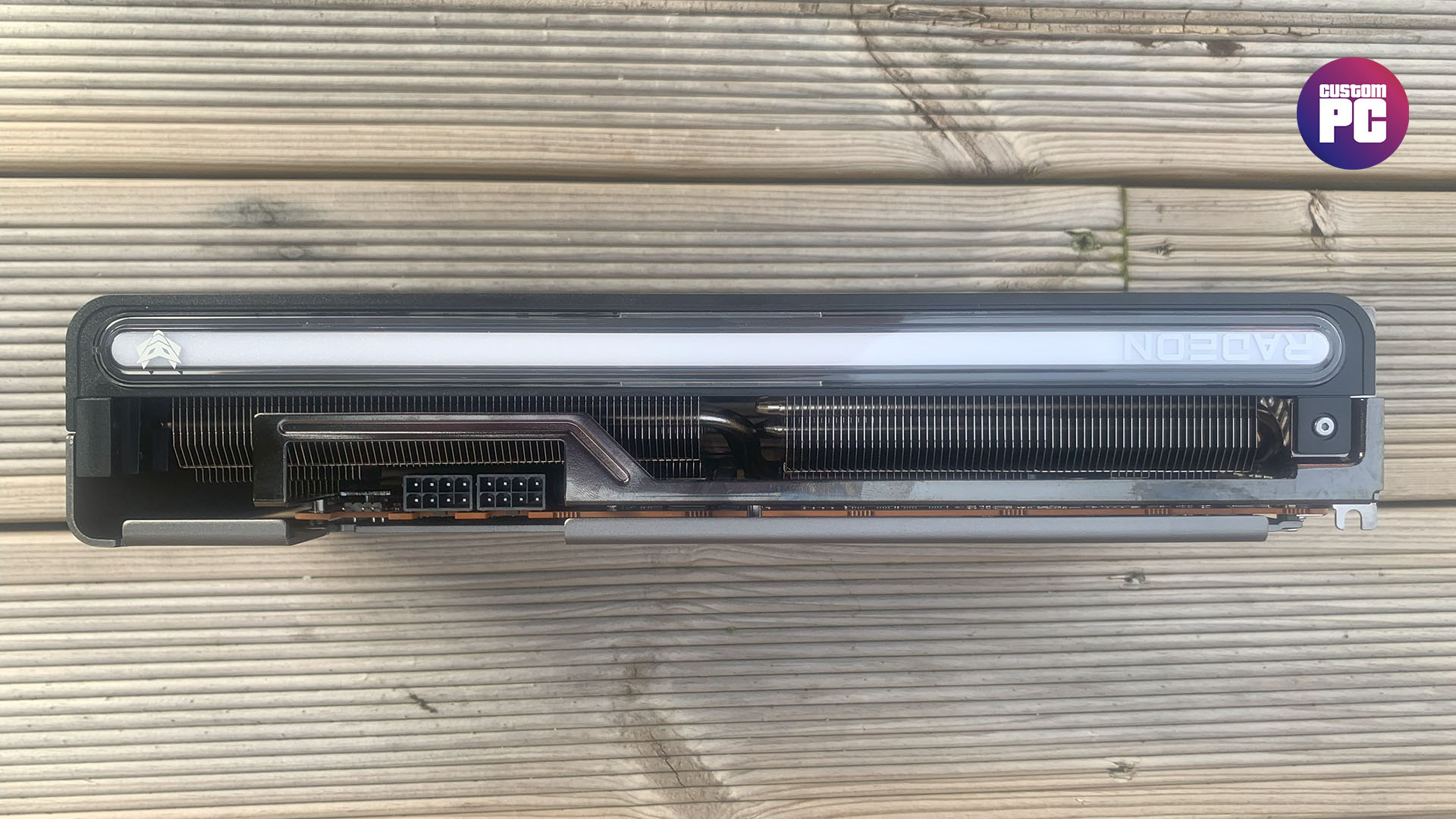
AMD Radeon RX 7800 XT frame rate
If you’re not bothered by ray tracing, and you want the fastest rasterization frame rates for your money, then the Radeon RX 7800 XT offers superb bang per buck. In three of our game tests – Assassin’s Creed Valhalla, Cyberpunk 2077, and Metro Exodus, it absolutely pummels the Nvidia GeForce RTX 4060 Ti, and is well in front of the RTX 4070.
The only outlier is in Doom Eternal, but the difference between the RTX 4070 and the Radeon RX 7800 XT is tiny in this test – just over 2 percent at 1080p. The Radeon RX 7800 XT Doom Eternal frame rate average of 469fps at 1080p, and 365fps at 1440p, are still fantastic results. The RX 7800 XT can also handle this game at 4K, with an average of 198fps.
Meanwhile, the Radeon RX 7800 XT Assassin’s Creed Valhalla frame rate average of 149fps is a superb result, being on par with the GeForce RTX 4070 Ti, and well ahead of the 140fps and 115fps of the RTX 4070 and RTX 4060 Ti. Impressively, the 7800 XT can also play this game at 4K, with a 72fps average and 53fps 99th percentile result. Despite having fewer stream processors, the RX 7800 XT is also consistently over 10fps quicker than the Radeon RX 6800 XT in this test.
Next up, the Radeon RX 7800 XT Cyberpunk 2077 frame rate average of 126fps at 1080p is again a superb result, being 13fps quicker than the RTX 4070 with Ultra settings. It stays well ahead of the RTX 4070 at 2,560 x 1,440 and 4K in this game as well, as well as the last-gen GeForce RTX 3080.
The Radeon RX 7800 XT Metro Exodus frame rate average of 126fps is a great result as well, putting it ahead of the RTX 3080 and RTX 4070, and the RX 7800 XT is convincing in this game at 2,560 x 1,440 tool, averaging 106fps. In this game, we also ran the Sapphire card at the AMD stock clock speed to see what difference you get from Sapphire’s overclock. It’s a decent boost, pushing the average frame rate to 111fps at 2,560 x 1,440 – an increase of 5fps.
AMD Radeon RX 7800 XT ray tracing
Unsurprisingly, ray tracing is the Achilles’ heel of the Radeon RX 7800 XT, but it’s not as far behind Nvidia as you might expect for the price. We get the feeling that the Radeon RX 7800 XT was originally slated to be priced at around $649, like its predecessor, but that AMD had to reprice it aggressively in order for it to be able to compete.
If the RX 7800 XT was up against the RTX 4070 Ti, then it would lose when it comes to ray tracing, but it holds its own surprisingly well against the RTX 4070 and 4060 Ti. One standout result is the Radeon RX 7800 XT Doom Eternal ray tracing frame rate average of 278fps at 1080p, which is 50fps behind the RTX 4070, but a huge 221fps in front of the RTX 4060 Ti 8GB, thanks to its 16GB of memory and wide memory bus. It’s not as fast as the RTX 4070 here, but its performance is still very quick, and the lower price of the Radeon RX 7800 XT helps soften the blow here.
The Radeon RX 7800 XT Metro Exodus ray tracing frame rate average of 101fps at 1080p is also a really solid result, being only 4fps behind the RTX 4070, and its 99th percentile result of 64fps is even 10fps faster than that of the RTX 4070. The overclock on this Sapphire card even pushes the RX 7800 XT beyond the performance of the RTX 4070 (and the last-gen RTX 3080) at this resolution.
The difference between the two GPUs is similar in this game when you move up to 2,560 x 1,440, with a still perfectly playable average of 78fps with a 53fps 99th percentile result. Playing this game at 4K pushes the limits of the RX 7800 XT, but its 43fps average here is still only 2fps behind the RTX 4070.
The big outlier here is Cyberpunk 2077. The Radeon RX 7800 XT Cyberpunk 2077 ray tracing frame average is 53fps at 1080p with the Medium ray tracing preset, and 35fps at 2,560 x 1,440. This is still quicker than the RTX 4060 Ti, which is a good win for AMD, considering that the RX 7800 XT is the same price as the 16GB RTX 4060 Ti. However, it’s a good 13fps behind the RTX 4070 in this test at 1080p.
Add FSR to the equation and the Radeon RX 7800 XT hits a decent average of 62fps at 2,560 x 1,440 at the medium ray tracing preset. That’s 11fps behind the RTX 4070 with DLSS Super Resolution enabled, and the latter will look better too.
Of course, the trump card Nvidia can play here is DLSS 3. Nvidia’s AI frame generation tech offers a fantastic way to massively increase frame rates, and while AMD is working on FSR 3 frame generation, it’s not out yet. In the meantime, Nvidia has ray tracing in games that support DLSS 3 sewn up.
For example, the RTX 4070 can run Cyberpunk 2077 in its stunning-looking Overdrive mode at 86fps with DLSS 3 enabled at 1080p, and 49fps without it. Comparatively, the RX 7800 XT could only average an awful result of 17fps.
In short, the Radeon RX 7800 XT can handle a good amount of ray tracing, especially compared to the RTX 4060 Ti. However, it really struggles with the demands of intensive ray tracing tasks, such as Cyberpunk 2077’s Overdrive mode, and DLSS 3 gives Nvidia a serious advantage in these scenarios.
AMD Radeon RX 7800 XT power draw
The AMD Radeon RX 7800 XT power draw is 452W, when measuring the total output of our test system at the wall. This is in the same ballpark as the RTX 4070 Ti, which is faster across the board, and it’s significantly higher than the 369W drawn by our system with the RTX 4070 installed. AMD’s latest GPUs are more power-efficient than their last ones, but Nvidia is still the winner when it comes to performance per watt.
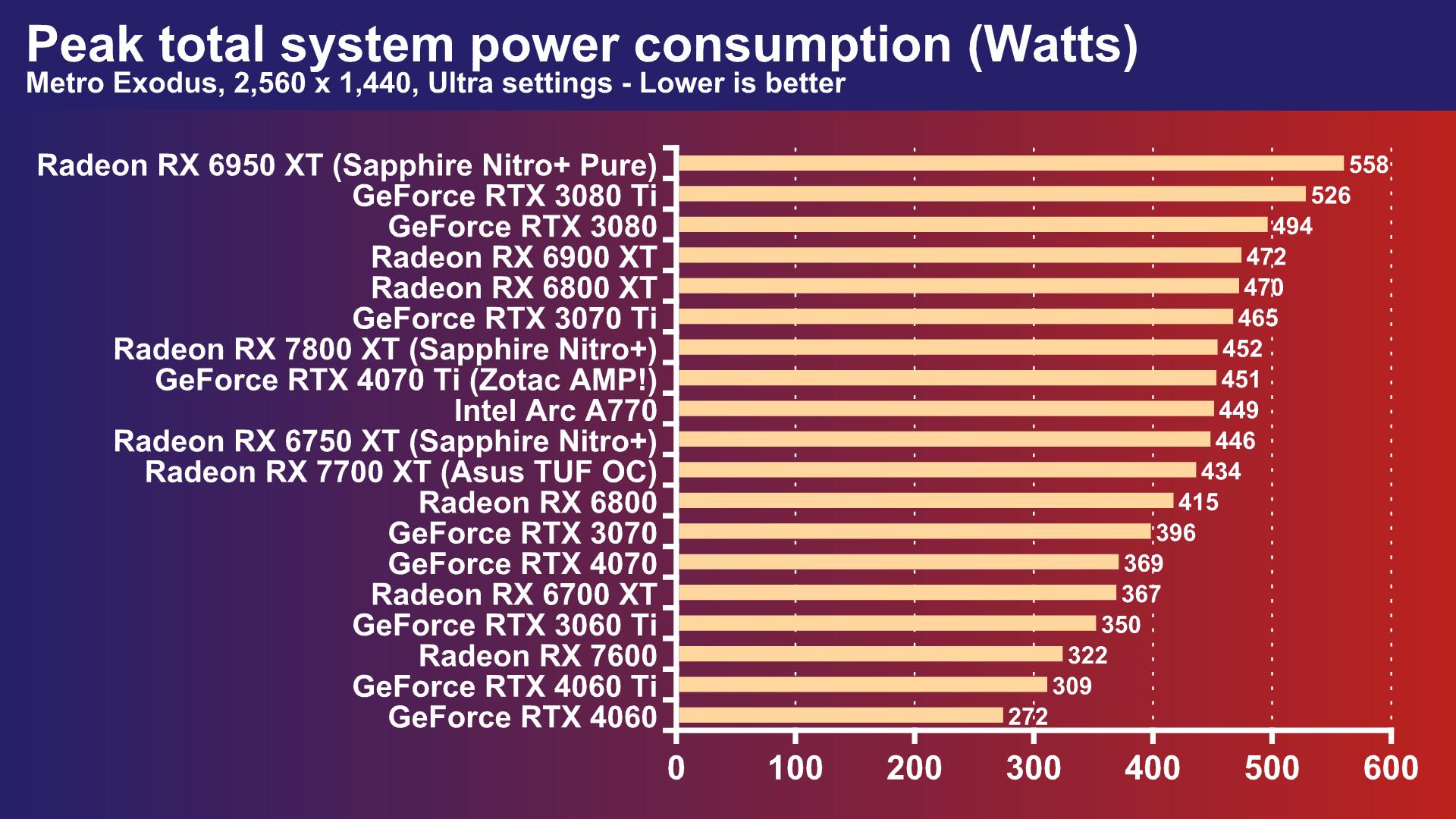
AMD Radeon RX 7800 XT pros and cons
Pros
- Great value
- Amazing rasterization performance
- Decent memory config
Cons
- No AI frame generation tech
- RTX 4070 is faster at ray tracing
- High power draw
AMD Radeon RX 7800 XT specs
The AMD Radeon RX 7800 XT specs list is:
| GPU | Navi 32 |
| Compute units (CUs) | 60 |
| Stream processors | 3,840 |
| RT cores | 60 |
| AI accelerators | 120 |
| ROPs | 96 |
| Game clock | 2124 MHz |
| Boost clock | 2430 MHz |
| L2 cache | 4 MB |
| L3 cache (2nd-gen Infinity Cache) | 64 MB |
| Memory | 16 GB GDDR6 |
| Memory bus | 256-bit |
| Memory clock | 2425 MHz (19.5 GHz effective) |
| Memory bandwidth | 624 GB/s |
| Interface | 16x PCIe 4 |
| Total board power (TBP) | 263W |
| Recommended PSU | 700W |
| Power connectors | 2 x 8-pin |
AMD Radeon RX 7800 XT price
The Radeon RX 7800 XT price is $499, which is significantly cheaper than the GeForce RTX 4070, and the same price as the GeForce RTX 4060 Ti 16GB.
Price: $499 (£489).
AMD Radeon RX 7800 XT conclusion
As with all of AMD’s recent GPUs, the Radeon RX 7800 XT is a mixed bag, but the excellent price of $499 gives you a serious amount of graphics performance for the money. It thrashes the RTX 4060 Ti 8GB, it’s generally ahead of the last-gen RTX 3080 (even in ray tracing), and it beats the RTX 4070 in straight shader performance too.
These are all solid achievements for a $499 GPU, and it’s great to see a hefty memory config on a card at this price too. The overclock on the Sapphire Nitro+ card we tested also gives it a decent speed boost if you can afford to pay an extra $50 for it, and it’s a fantastic card that looks stunning too. However, if you can’t, the RX 7800 XT is still highly capable at stock speed.
There are some caveats, though. Firstly, the ray tracing performance is behind the RTX 4070. The lower price helps justify this to a degree, and the RX 7800 XT is still surprisingly good at ray tracing, but it’s disappointing that you can’t run the latest Cyberpunk 2077 Overdrive on this GPU. If you’d just spent $499 on a brand new graphics card, finding you can’t run the latest fancy-looking graphics modes would be a real disappointment.
The lack of any frame generation tech also hurts the RX 7800 XT. AMD is working on FSR 3 frame generation, but DLSS 3 and its use of Nvidia’s latest Tensor cores is the main saving grace for Nvidia’s current Ada lineup. The tech significantly increases frame rates with minimal visual impact, enabling you to run games at stunning graphics settings. That said, only a minority of games support DLSS 3, and the RX 7800 XT’s rasterization performance is incredible for the money.
This all means that the RTX 4070 is the better all-round choice if you want both decent rasterization and ray tracing performance, but only if you can afford it. In the middle pricing ground between the Radeon RX 7600 and the RTX 4070, however, the Radeon RX 7800 XT carves out a good niche for itself. It’s a much better buy than the RTX 4060 Ti, and it confidently beats last-gen cards, such as the RTX 3080, at almost everything, including ray tracing.
The lack of frame generation tech, and the lagging ray tracing performance, means it’s not a straight win for the RX 7800 XT. However, if you can’t run to the cost of the RTX 4070, and frame rates are a bigger priority for you than maxing out ray tracing settings, the Radeon RX 7800 XT is the best mid-range option and the current best gaming GPU for under $500, earning it a place on our guide to the best graphics card.
